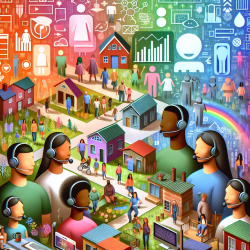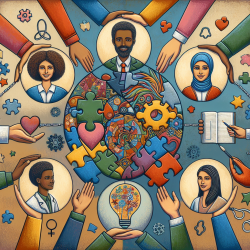Introduction
The landscape of LGBTQ+ neighborhoods is evolving, and understanding these changes is crucial for practitioners who aim to create inclusive and effective online therapy services. The research article "Who Are the People in Your Gayborhood? Understanding Population Change and Cultural Shifts in LGBTQ+ Neighborhoods" provides insightful data that can help practitioners enhance their skills and adapt to these shifts.
Understanding the Dynamics of LGBTQ+ Neighborhoods
According to the research, LGBTQ+ neighborhoods have historically served as safe havens for sexual minorities, providing spaces for community building, socialization, and activism. However, these neighborhoods are experiencing significant demographic and cultural shifts. Factors such as increased acceptance of LGBTQ+ individuals, technological advancements, and economic changes are contributing to these transformations.
Key Takeaways for Practitioners
The research highlights several key points that can be leveraged to improve online therapy services for children in LGBTQ+ communities:
- Inclusivity Matters: LGBTQ+ neighborhoods are becoming more inclusive, attracting not only gay men but also other sexual minorities and allies. Practitioners should ensure that their services are inclusive and culturally sensitive to the diverse needs of these communities.
- Technological Integration: The rise of digital and virtual connections is reshaping how LGBTQ+ individuals interact and form communities. Online therapy platforms should incorporate these technological advancements to create more engaging and accessible services.
- Community Building: Despite the physical changes in LGBTQ+ neighborhoods, the sense of community remains strong. Practitioners should focus on fostering a sense of belonging and community among their clients, even in a virtual setting.
- Mental Health Support: The research indicates that LGBTQ+ individuals experience unique stressors related to their minority status. Providing targeted mental health support can help mitigate these stressors and improve overall well-being.
Encouraging Further Research
While the research provides valuable insights, it also underscores the need for continuous study and adaptation. Practitioners are encouraged to stay informed about ongoing changes in LGBTQ+ neighborhoods and incorporate new findings into their practice. This commitment to data-driven decision-making will ensure that online therapy services remain relevant and effective.
Conclusion
Understanding the dynamics of LGBTQ+ neighborhoods is essential for creating inclusive and effective online therapy services. By leveraging the insights from the research, practitioners can enhance their skills and better serve the needs of children in these communities. To read the original research paper, please follow this link: Who Are the People in Your Gayborhood? Understanding Population Change and Cultural Shifts in LGBTQ+ Neighborhoods.










